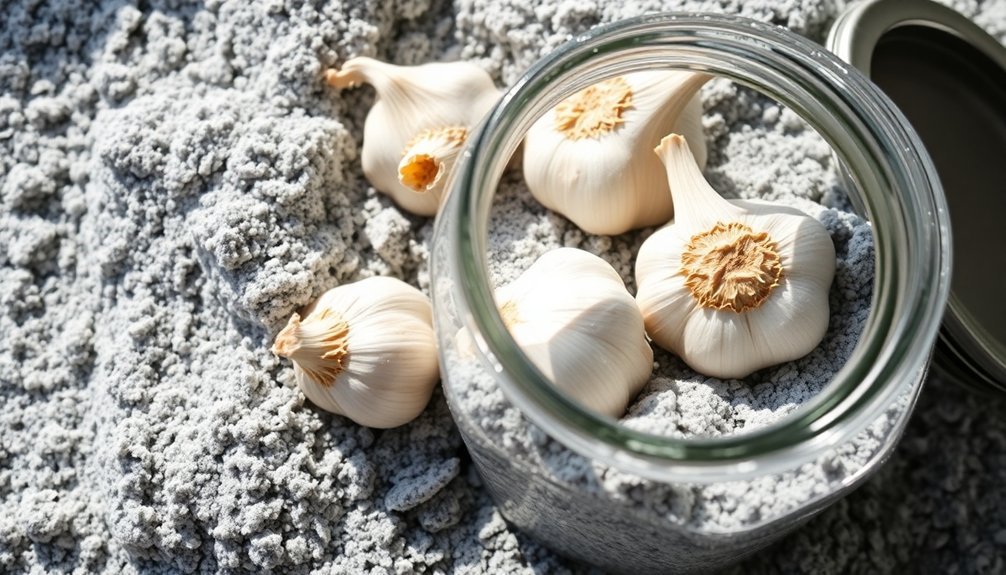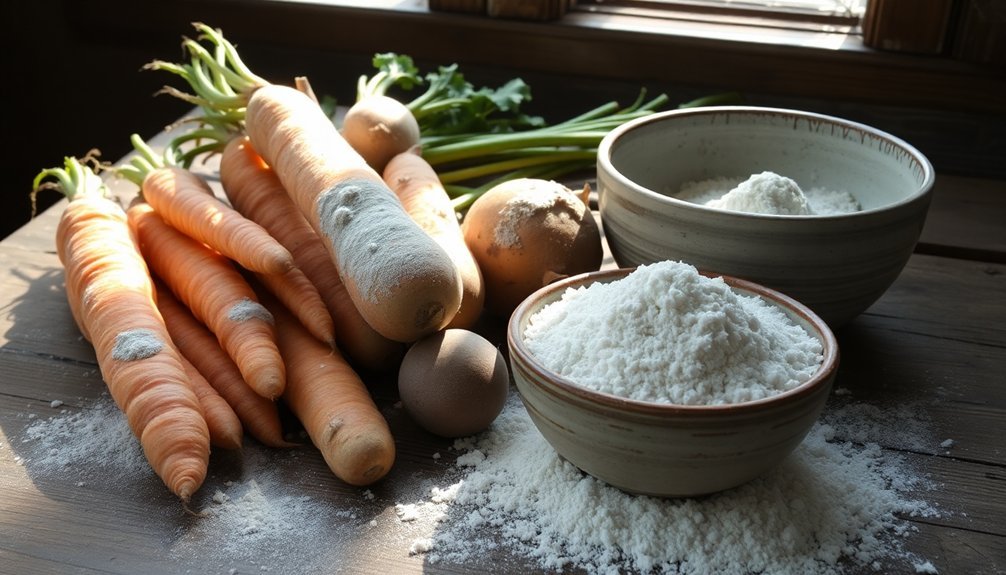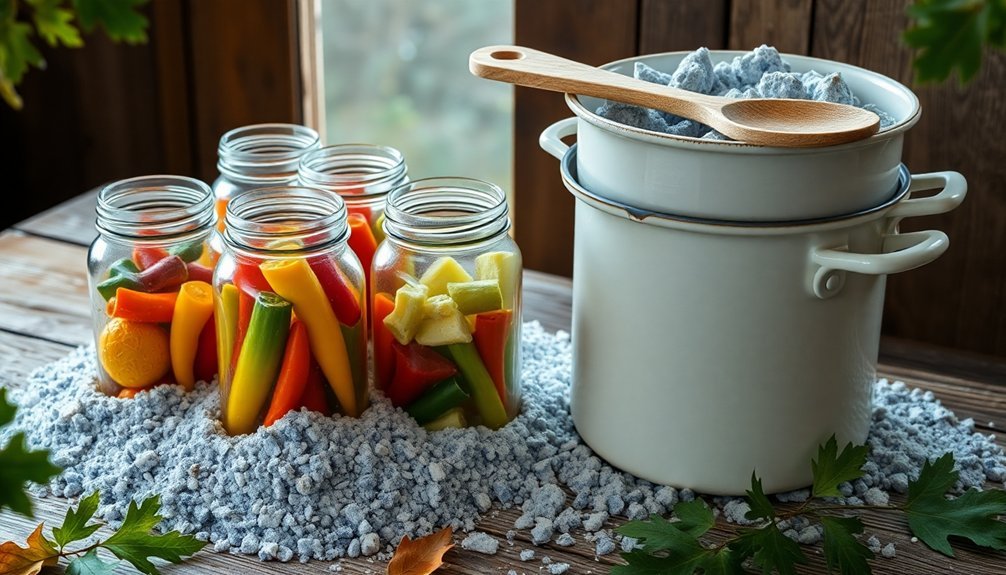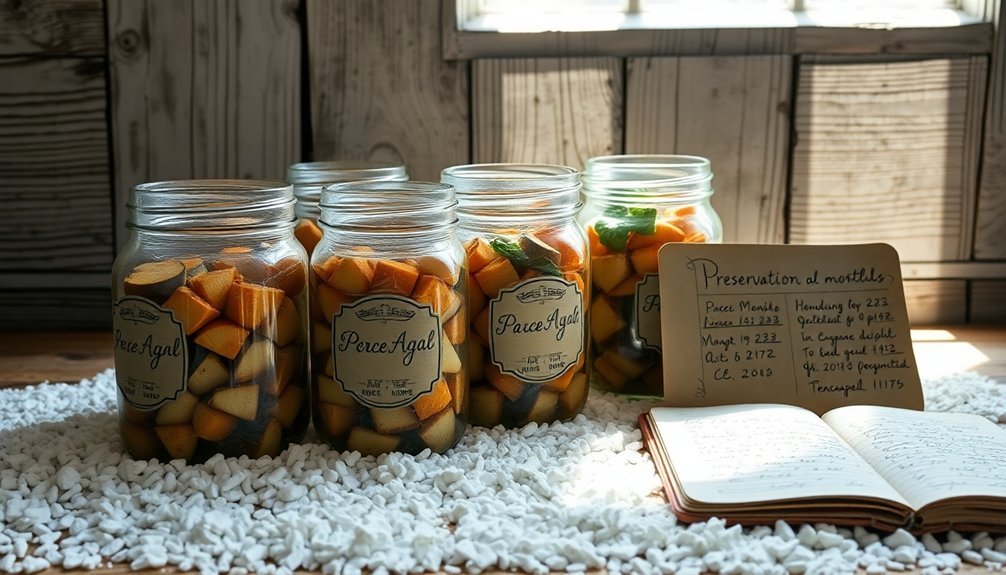Wood ash preservation lets you naturally extend your food's shelf life without modern refrigeration. You'll need clean, light gray hardwood ash that's completely cooled and sifted to remove debris. This method works best for tomatoes, hard cheeses, and eggs when stored in proper containers like earthenware crocks or wooden boxes. Layer your food items carefully, ensuring they don't touch, and surround them completely with ash. Keep your storage area cool and dark, between 50-65°F, and check items every 3-4 days for quality. With proper technique and monitoring, you'll discover how this ancient preservation method can transform your food storage approach.
Understanding Wood Ash Properties

Wood ash packs a powerful punch of essential minerals and compounds that make it an effective preservative and soil amendment. When you examine its composition, you'll find it's rich in calcium, making up 7-33% of its content, with significant amounts of potassium at 3-10% and magnesium at 1-2%.
One of its most important components is calcium carbonate, which can constitute up to 45% of the total ash weight.
You'll need to handle wood ash carefully due to its highly alkaline nature, with pH levels ranging from 9-13. This alkalinity comes primarily from the calcium carbonate content, which can convert to calcium oxide at higher temperatures. Research shows that using 1.5 kg of ash per kilogram of tomatoes provides optimal preservation results.
When you're selecting ash for preservation purposes, make sure you're using only hardwood ash from sources like maple or oak to avoid contamination.
The ash also contains valuable trace elements like iron, zinc, and copper, though their concentrations vary depending on burning temperatures.
You'll want to note that some elements can volatilize at higher temperatures, particularly potassium, sulfur, and copper. Understanding these properties is essential as they directly affect the ash's preservative capabilities and its interaction with foods.
Preparing Your Storage Space
Proper storage preparation is essential for successful food preservation with wood ash. You'll need to start by selecting the right container for your preservation needs. Wooden boxes, cardboard containers, or woven baskets work well, while earthenware crockery is particularly suitable for preserving cheese.
Make certain your chosen container can accommodate multiple layers of food and ash while maintaining a cool, dark environment. This layering system allows for storing 100 pounds of tomatoes before the first frost arrives.
Before you begin the preservation process, you'll need to prepare your storage space. Choose a location that's cool, dry, and away from direct sunlight, such as a basement or shaded area. The space should maintain a consistent temperature throughout the preservation period.
You'll want to keep your containers elevated off the ground and away from any potential moisture sources.
Check your storage area regularly for signs of pests or environmental changes that could affect your preserved foods. When you're ready to store your containers, verify they're properly sealed with loose-fitting covers or packing tape to keep the ash undisturbed.
Remember to arrange your containers so you can easily access them when needed and monitor their condition periodically to maintain ideal preservation conditions.
Selecting Suitable Food Items

Selecting the right foods for ash preservation is essential for success. You'll need to choose items that can withstand the alkaline environment and moisture-absorbing properties of wood ash. Hard cheeses like Gruyere, fresh tomatoes, eggs, meats, and various grains are excellent candidates for this preservation method. The natural wood ash coolness helps significantly extend food storage times.
For tomatoes, select only newly picked, ripe fruits without blemishes or soft spots. When preserving hard cheeses, verify they're properly dried and thick enough to withstand the preservation process. Eggs must be fresh and clean, while meats should be properly prepared before storage in hickory ash for ideal results. Grains and seeds need to be completely dry before preservation.
- Fresh tomatoes will develop wrinkled skin but maintain juicy pulp for 3-6 months
- Hard cheeses form a new protective rind during preservation
- Eggs can last up to a year when properly stored in ash
- Meat benefits from both preservation and flavoring when using hickory ash
- Grains and seeds remain pest-free due to ash's high pH and sterile properties
Remember that moisture content is significant – choose only dry items or those that can withstand the drying effects of wood ash preservation.
Safe Ash Collection Methods
You'll need to source ash exclusively from fires burning untreated wood to guarantee your preserving methods remain food-safe.
Let your wood ash cool completely before collecting it in a metal container, and always wear protective gloves to prevent burns during the gathering process.
Test your ash's purity by mixing it with water – pure wood ash should create a slippery, soap-like solution without any strange odors or discoloration.
Sourcing From Clean Fires
When collecting wood ash for food preservation, safety and cleanliness must be your top priorities. You'll need to source your ash exclusively from hardwoods like maple or oak, ensuring they haven't been chemically treated or pressure-treated.
Don't use ash from fires that contained plastics, household waste, or other hazardous materials, as these can contaminate your preserves and pose health risks.
For ideal safety and quality, you'll want to:
- Use only ash from clean-burning hardwood fires
- Verify the wood source is free from chemical treatments
- Keep your ash collection separate from regular waste
- Store the ash in a sealed, galvanized steel container
- Monitor the fire to prevent contamination from other materials
Set up your collection station away from other household activities and keep it properly sealed to prevent contamination.
You should wear protective gear, including safety gloves and a dust mask, when handling the ash. If you're unsure about your wood source, it's better to err on the side of caution and avoid using it for food preservation.
Remember to check your local regulations regarding wood ash collection and use, as requirements can vary by region.
Cool Before Handling
Once you've identified a clean hardwood source for your ash, proper cooling is the next essential step in safe collection.
You'll need to allow your ashes to cool completely for a minimum of 48 hours, though it's safer to wait 96 hours (four days) before handling them. During this time, don't disturb the ashes, as they need to reach a safe temperature naturally.
When you're ready to collect the cooled ashes, put on protective gear including gloves, a mask, and goggles.
Use only a galvanized steel or metal ash container with a secure lid for collection – never use plastic, cardboard, or paper containers. Place your metal container at least 10 feet away from buildings and keep it clear of flammable materials like firewood piles, garages, and wooden decks.
After collecting the ashes in your metal container, let them sit for an additional week before transferring them to their final container.
When you transfer the ashes, be careful not to introduce excess oxygen, which could reignite any remaining embers. Always verify the ashes are completely cool before proceeding with food preservation.
Testing Ash Purity
Proper ash purity testing is essential for safe food preservation. Before using wood ash for food preservation, you'll need to confirm its quality through several testing methods.
Start by examining the ash's color and texture – pure wood ash should appear light gray or white. You can conduct a simple pH test to validate its alkaline properties, which is characteristic of pure wood ash. For more thorough verification, consider having the ash tested for heavy metals and other inorganic compounds that could be harmful to food.
- Sift the ash through a fine-mesh screen to remove any unburned particles or debris
- Check for a uniform, powdery consistency without visible contaminants
- Look for a clean, light gray or white color without dark spots
- Ascertain there are no metallic pieces or other foreign materials
- Confirm the ash comes from untreated, chemical-free wood sources
Compare your ash samples with known standards to ascertain consistency in quality. If you're using the ash for commercial food preservation, you'll need to conduct regular testing to maintain safety standards.
Remember that different woods produce ash with varying properties, so document your wood sources and maintain consistent testing procedures for reliable results.
Essential Storage Equipment

Successful food preservation with wood ash begins with the right storage equipment. You'll need containers that can maintain a stable, oxygen-free environment. Traditional earthenware or stoneware crocks work best, but you can also use cardboard boxes lined with ash if necessary. Your containers must have proper lids or plates that can be weighted down with stones or bricks to create an airtight seal.
| Equipment Type | Purpose |
|---|---|
| Storage Vessels | Crocks or lined cardboard boxes to hold food and ash |
| Sealing Items | Matching lids or weighted plates to prevent air entry |
| Sifting Tools | Hardware cloth frame to remove large charcoal pieces |
| Measuring Tools | Scale or cups to measure proper ash quantities |
| Handling Tools | Knife, spoon, or trowel for food and ash placement |
Keep your equipment clean and dry before use to prevent contamination. You'll want to store your preservation containers in a cool, dark place with stable temperature, such as a cellar or basement. The location should stay relatively dry to protect against moisture damage. Make sure you can easily access your storage area to check on your preserved foods periodically. Remember to label your containers with contents and preservation dates.
Wood Ash Preservation Process
Following four essential steps guarantees effective wood ash preservation. First, you'll need properly prepared hardwood ash that's been sifted multiple times to remove debris and cooled completely.
Second, select only the highest quality foods – firm tomatoes without blemishes or hard cheeses of proper thickness.
Third, create your preservation layers carefully, ensuring food items don't touch each other and are fully surrounded by ash.
Fourth, store your containers in a cool, dark place to maintain ideal preservation conditions.
Here's what successful wood ash preservation looks like:
- Perfectly sifted ash from hardwoods like maple or oak forms a fine, powder-like consistency
- Tomatoes arranged upside down with ash filling every space between them
- Hard cheese surrounded by 1 to 1.5 inches of ash on all sides in a stoneware pot
- Containers stored in a cool, dark space away from moisture and temperature fluctuations
- No direct contact between food items, with complete ash coverage throughout
Remember to handle wood ash carefully due to its high alkalinity, and always store your ash supply outdoors on a non-combustible surface, protected from wind and moisture.
Storage Duration Guidelines

Different foods preserved in wood ash have varying storage durations, with tomatoes lasting up to 6 weeks under ideal conditions and hard cheeses maintaining quality for up to 3 months.
To achieve the best storage life for tomatoes, use 1.5 kg of wood ash per kilogram of produce and store them in a cool, dark basement. While some farmers report up to 6 months of preservation, most studies confirm the 6-week duration as more realistic.
For cheese preservation, you'll need to dry or age it before storing in wood ash. Choose thicker pieces to account for the new rind that'll form during storage, and place them in covered stoneware pots in a cool cellar. The ash creates a protective layer that helps maintain the cheese's quality.
While wood ash has historically been used to preserve other foods like eggs and meat, there's limited scientific data on their specific storage durations.
You'll want to use only clean, uncontaminated wood ash and store it in covered metal containers. After use, you can repurpose the ash as a soil amendment, but be careful not to over-alkalize your soil.
Monitoring Preserved Foods
Once you've stored your foods in wood ash, regular monitoring becomes the key to maintaining their quality. You'll need to check both visual and physiological parameters regularly.
Watch for color changes, surface conditions, and texture variations while measuring pH levels and weight loss to guarantee proper preservation. Monitor your storage environment's temperature and humidity, as these factors greatly impact preservation success.
Pay special attention to signs of microbial activity, including mold, fungi, or bacterial growth. The alkaline properties of wood ash should help inhibit these problems, but you'll want to catch any issues early.
Compare your ash-preserved foods with control samples to gauge the effectiveness of your preservation method.
- Inspect the surface of preserved foods every 3-4 days for signs of deterioration
- Use a digital thermometer to maintain storage temperatures between 50-65°F
- Check wood ash moisture levels by squeezing a handful – it should barely hold together
- Document color changes and texture variations in a monitoring log
- Look for white or green spots that could indicate mold growth
Remember to maintain proper ventilation in your storage area and protect it from direct sunlight and excess moisture.
Replace wood ash if it becomes too damp or contaminated.
Frequently Asked Questions
Can Wood Ash From Different Types of Trees Affect Food Preservation Differently?
Yes, the type of tree matters for food preservation. You'll get better results with hardwood ash since it's higher in nutrients and minerals, while softwood ash has lower concentrations and isn't as effective.
How Does Wood Ash Preservation Compare to Modern Freezing Methods?
You'll find wood ash preservation's more sustainable and power-independent than freezing, though it won't preserve food quality as well. While freezing's more convenient, wood ash offers reliable preservation without electricity or technology.
Is It Safe to Consume Ash-Preserved Foods During Pregnancy?
You shouldn't consume ash-preserved foods during pregnancy. They pose risks of bacterial contamination and aren't standardized for safety. Stick to modern preservation methods like freezing or canning to protect yourself and your baby.
Can Wood Ash Preservation Affect the Nutritional Value of Foods?
Yes, wood ash preservation can affect your food's nutrition. You'll get increased minerals like iron and zinc, but you may see some protein quality reduction. The method helps maintain stable storage conditions for nutrients.
What Signs Indicate Wood Ash-Preserved Food Has Gone Bad?
You'll know your ash-preserved food has spoiled if you notice unpleasant odors, visible mold, slimy textures, or unusual discoloration. Also watch for softening, off-putting smells, and any signs of pest infestation.
In Summary
You've now learned how to effectively preserve food using wood ash, an age-old technique that's both practical and sustainable. Remember to collect clean ash, prepare your storage space properly, and monitor your preserved items regularly. By following these guidelines, you'll be able to extend your food's shelf life naturally and safely. Keep experimenting with different foods and ash quantities to find what works best for your needs.





Leave a Reply